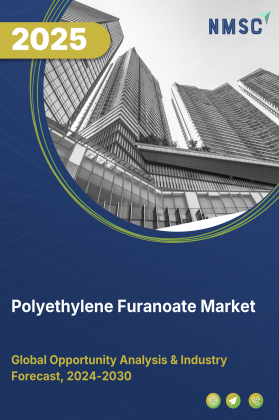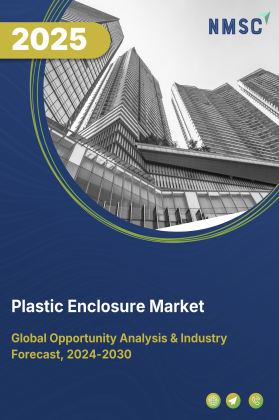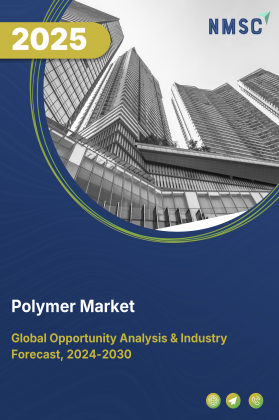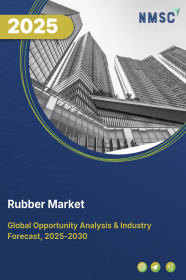
Polyethylene Furanoate Market by Technology (Bio-based FDCA Route, PET Substitution, Advanced Catalytic Processes, and Others), by Formulation (Granules, Films, Preforms, and Fibers), by Application (Bottles, Films & Pouches, Trays & Containers, and Fibers & Yarns), and by End User (Packaging, Consumer Goods, Healthcare, Automotive & Electronics, and Others), and Others – Global Opportunity Analysis and Industry Forecast, 2025–2030
Industry Outlook
The global Polyethylene Furanoate Market size was valued at USD 36.75 million in 2024, with an estimation of USD 39.84 million in 2025 and is predicted to reach USD 59.63 million by 2030 with a CAGR of 8.40% from 2025-2030.
The industry is witnessing rapid growth, driven by the urgent demand for sustainable alternatives in the packaging industry. Traditional petroleum-based plastics, despite being cost-effective, contribute significantly to environmental pollution and greenhouse gas emissions due to their non-biodegradable nature.
In contrast, PEF is a 100% bio-based polymer derived from renewable feedstocks such as plant sugars, offering an eco-friendly, low-carbon alternative. Its full recyclability within existing PET recycling streams allows seamless integration into current infrastructure, minimizing operational disruptions and costs.
The adoption of PEF polymer is further accelerated by FMCG companies and packaging firms pursuing ambitious net-zero and sustainability targets, as well as growing consumer preference for environmentally responsible brands. The beverage industry has emerged as a key growth segment, with PEF bottles providing superior mechanical strength, oxygen barrier properties, and carbonation retention compared to conventional PET, enabling thinner, lighter packaging without compromising performance.
Governments are also supporting the shift toward bio-based plastics through regulations and incentives; for instance, the European Council’s Packaging and Packaging Waste Regulation, effective from January 2025, explicitly encourages the use of bio-based materials like PEF to achieve circular economy and climate-neutrality objectives.
Overall, the polyethylene furanoate market growth is positioned at the intersection of sustainability, regulatory compliance, and consumer demand, creating strong momentum for adoption across packaging and related industries.
Rising Demand for Sustainable Packaging Materials
Global concerns around plastic pollution and climate change have accelerated the shift toward sustainable alternatives in the packaging industry. Traditional petroleum-based plastics, while cost-effective, contribute heavily to greenhouse gas emissions and environmental degradation due to their non-biodegradable nature. In contrast, PEF is a 100% bio-based polymer derived from renewable feedstocks such as plant sugars, making it an eco-friendly solution.
Moreover, furanoate polyester is fully recyclable within existing PET recycling streams, allowing companies to integrate it into current infrastructure without significant cost or operational disruptions. Major FMCG companies and packaging firms are setting ambitious net-zero and sustainability goals, driving large-scale adoption of materials like PEF to reduce their environmental footprint. This demand is further reinforced by consumer preference for brands using eco-friendly packaging, creating a dual push from both industry regulations and market trends toward bio-based plastics like PEF.
Increasing Use in the Food and Beverage Industry Propels Market Growth
The beverage industry is one of the fastest-growing application areas for PEF due to its combination of sustainability, durability, and performance. Major beverage manufacturers are under immense pressure to meet ESG targets while maintaining brand quality. PEF bottles offer a lower carbon footprint and better mechanical strength compared to PET, allowing for thinner walls without compromising structural integrity.
Additionally, PEF’s ability to retain carbonation levels and prevent oxygen ingress ensures that beverages like carbonated soft drinks, beer, and bottled water remain fresh for longer durations. Several pilot projects and commercial collaborations have already begun exploring 100% bio-PET bottles, with companies viewing this as a differentiator in the competitive beverage market. As sustainability becomes a key brand value, the demand for PEF-based bottles is expected to rise significantly, driving overall polyethylene furanoate market expansion.
Government Regulatory Support and Circular Economy Initiatives Boost the Market Growth
Governments worldwide are increasingly promoting bio-based and recyclable materials to reduce carbon emissions and support circular economy principles, and Polyethylene Furanoate is perfectly aligned with these initiatives. A notable example is the European Council’s approval of the Packaging and Packaging Waste Regulation in December 2024, effective from January 2025, which explicitly includes bio-based plastics like PEF as essential tools for achieving the EU’s climate-neutrality and circular economy goals.
The regulation mandates the European Commission to define criteria for bio-based feedstocks in packaging, promote recyclable and sustainable materials, and encourage the adoption of innovative polymers where recycling solutions for food-contact packaging are limited. PEF’s bio-based origin, full recyclability, and low carbon footprint make it an ideal solution for companies aiming to meet these regulatory standards, demonstrating their commitment to sustainability while driving broader adoption of eco-friendly packaging materials.
High Production Costs and Scale-Up Challenges Restrain the Market Growth
Despite its promising properties, PEF production remains more expensive than conventional PET, primarily due to the use of specialized catalysts and the relatively limited scale of commercial manufacturing. These higher costs make PEF less attractive for cost-sensitive applications, particularly in emerging markets or for high-volume products. Additionally, scaling up production to meet global demand poses technical and logistical challenges, which slow adoption until economies of scale are achieved.
Rising Demand for Sustainable and High-Performance Packaging Creates Future Opportunity
The growing global emphasis on sustainability and circular economy initiatives presents a significant opportunity for the polyethylene furanoate market demand. Its bio-based origin, superior barrier properties, and recyclability make it an ideal alternative for food, beverage, and pharmaceutical packaging.
With governments implementing stricter regulations on single-use plastics and companies aiming to meet ESG targets, PEF adoption is expected to accelerate. Furthermore, innovation in cost-effective production technologies could expand its application across new regions and industries, creating a substantial growth opportunity for the polyethylene furanoate market manufacturers and investors.
Market Segmentation and Scope of Study
The polyethylene furanoate market report is divided on the basis of technology, formulation, application, end user and region. On the basis of technology, the market is grouped into bio-based FDCA route, PET substitution, advanced catalytic processes, and others. On the basis of formulation, the market is segmented into granules, films, preforms, and fibers. On the basis of application, the market is categorized into bottles, films and pouches, trays and containers, and fibers and yarns. On the basis of end user, the market is divided into packaging, consumer goods, healthcare, automotive and electronics, and others. Regional breakdown and analysis of each of the aforesaid segments includes regions comprising of Asia-Pacific, North America, Europe, and RoW.
Geographical Analysis
The polyethylene furanoate market share in North America is primarily driven by stringent environmental regulations and corporate sustainability initiatives. Governments and states, such as California, are enforcing policies to reduce plastic waste and promote bio-based alternatives.
Additionally, major beverage and FMCG companies are increasingly adopting sustainable packaging solutions to meet ESG targets, creating strong demand for PEF. The presence of technology leaders and R&D centers in the U.S. also facilitates innovation in PEF production and commercialization.
Europe is a global leader in driving PEF adoption due to regulatory support and the rapid growth of the packaging industry. The Packaging and Packaging Waste Regulation (PPWR), effective January 2025, explicitly includes bio-based plastics like PEF as part of the EU’s climate-neutrality and sustainability goals.
Alongside the EU Green Deal and Circular Economy Action Plan, European companies are incentivized to adopt recyclable and high-performance materials, boosting PEF demand in food, beverage, and specialty packaging applications. According to recent market reports, the European packaging industry continues to expand rapidly, further driving the adoption of innovative, sustainable polymers like PEF to meet both environmental regulations and rising consumer demand for eco-friendly packaging.
Asia-Pacific holds the dominant share of the polyethylene furanoate industry at present and is expected to continue its dominance during the forecast period. This is primarily due to the rapid growth of the packaging industry within the region. According to a report published by the Packaging Industry Association of India, the packaging market in India is expected to rise from USD 50.50 billion in 2019 to USD 204.81 billion by 2025, significantly increasing the demand for PEF and propelling industry growth.
Additionally, countries such as Japan, China, and India are witnessing strong adoption of bio-based plastics in bottled water, soft drinks, and processed foods. Government policies supporting green manufacturing and waste reduction, coupled with rising consumer awareness of sustainable packaging, further strengthen the polyethylene furanoate market demand across the APAC region.
In regions such as Latin America, the Middle East, and Africa, the market is driven by growing awareness of sustainable packaging and increasing adoption of bio-based materials. Emerging economies are gradually implementing circular economy initiatives and encouraging companies to reduce environmental impact through recyclable and eco-friendly packaging solutions.
Partnerships with global beverage and packaging companies are supporting the commercialization of PEF in these regions. While market maturity is still developing compared to North America, Europe, and APAC, the rising emphasis on sustainability and environmental responsibility is steadily creating opportunities for PEF adoption.
Strategic Innovations Adopted by Key Players
Key players in the polyethylene furanoate industry are driving market growth through regulatory approvals that expand food-contact applications and strategic partnerships aimed at accelerating FDCA and PEF adoption across high-demand regions.
-
In October 2024, Avantium secured U.S. FDA Food Contact Notification approval for its PEF; this allows its PEF to be used as packaging for all food types, room temperature, refrigerated, or frozen, excluding only high-alcohol foods over 15%, infant formula, or human milk.
-
In October 2024, Avantium N.V. partnered with SCG Chemicals (SCGC) to accelerate FDCA and PEF implementation in Asian markets.
Key Benefits
-
The report provides quantitative analysis and estimations of the industry from 2025 to 2030, that assists in identifying the prevailing polyethylene furanoate market opportunities.
-
The study comprises a deep-dive analysis of the current and future polyethylene furanoate market trends to depict prevalent investment pockets in the market.
-
Information related to key drivers, restraints, and opportunities and their impact on the market is provided in the report.
-
Competitive analysis of the players, along with their market share is provided in the report.
-
SWOT analysis and Porters Five Forces model is elaborated in the polyethylene furanoate market study.
-
Value chain analysis in the market study provides a clear picture of roles of stakeholders
Polyethylene Furanoate Market Key Segments
By Technology
-
Bio-based FDCA Route
-
PET Substitution
-
Advanced Catalytic Processes
-
Others
By Formulation
-
Granules
-
Films
-
Preforms
-
Fibers
By Application
-
Bottles
-
Carbonated beverages
-
Water & juices
-
Alcoholic beverages
-
-
Films & Pouches
-
Trays & Containers
-
Fibers & Yarns
By End User
-
Packaging
-
Consumer Goods
-
Healthcare
-
Automotive & Electronics
-
Others
By Region
-
North America
-
The U.S
-
Canada
-
Mexico
-
-
Europe
-
The UK
-
Germany
-
France
-
Italy
-
Spain
-
Denmark
-
Netherlands
-
Finland
-
Sweden
-
Norway
-
Russia
-
Rest of Europe
-
-
Asia-Pacific
-
China
-
Japan
-
India
-
South Korea
-
Australia
-
Indonesia
-
Singapore
-
Taiwan
-
Thailand
-
Rest of Asia-Pacific
-
-
Rest of the World
-
Latin America
-
Middle East
-
Africa
-
Key Players
-
Origin Materials, Inc.
-
Toyobo Co., Ltd.
-
AVA Biochem AG
-
Selenis Portugal S.A.
-
Zhejiang Sugar Energy Technology Co., Ltd.
-
Hefei Leaf Biotech Co., Ltd.
-
Zhongke Guosheng (Hangzhou) Technology Co., Ltd.
-
Wankai New Materials Co., Ltd.
Report Scope and Segmentation
|
Parameters |
Details |
|
Market Size in 2025 |
USD 39.84 Million |
|
Revenue Forecast in 2030 |
USD 59.63 Million |
|
Growth Rate |
CAGR of 8.40%from 2025 to 2030 |
|
Analysis Period |
2024–2030 |
|
Base Year Considered |
2024 |
|
Forecast Period |
2025–2030 |
|
Market Size Estimation |
Billion (USD) |
|
Growth Factors |
|
|
Countries Covered |
28 |
|
Companies Profiled |
11 |
|
Market Share |
Available for 10 companies |
|
Customization Scope |
Free customization (equivalent to up to 80 working hours of analysts) after purchase. Addition or alteration to country, regional, and segment scope. |
|
Pricing and Purchase Options |
Avail customized purchase options to meet your exact research needs. |

















 Speak to Our Analyst
Speak to Our Analyst





















